The appearance of large, glossy green leaves is the best sign that your Monstera plant is flourishing. This is true if you have been able to make a large part of the monstera plant’s natural habitat or if you have at least made a place where it feels at home.
Everything seems to be going well, but one day you notice a small brown spot on your monstera. Sure, it’s not the end of the world, but what can you do if these unsightly spots appear on every leaf?
Don’t waste time because spots, discolorations, and other small marks on leaves and stems are not only ugly but also ways that plants tell you something is wrong. You’ll find out what causes brown spots on monstera and how to identify and treat them here.
Contents
Why Do Brown Spots Appear on Monstera?

Monstera and other plants take water and nutrients from the substrate. These nutrients start at the roots and move up the plant until they reach the leaves.
If the roots, for whatever reason, can’t meet the monstera’s need for water, the plant will start to spread to the limits it can reach.
Lack of moisture causes tissue death and dehydration in the leaves, especially at the tips. Of course, this isn’t the case for every brown spot.
They are sometimes caused by parasites and fungi that lodge in the monstera leaf, reproduce, and spread through the air through contact with tools and other objects.
In many cases, these brown spots do not directly threaten the life of the monstera because they do not attack the roots.
However, by damaging the leaf’s green surface, they disrupt the photosynthetic process and, thus, the plant’s ability to produce its food.
In this way, your monstera is weakened and may even die in the long run. Because of this, identifying and fixing the issue is crucial. A few of the following might cause the brown spots on your monster plant.
Monstera Brown Spot Diagnosis
The first step in resolving a problem with brown spots on monstera leaves is determining what is causing them.
There are different kinds of brown spots, so you need to take the plant in question, sit in a place with a lot of light, and even bring a magnifying glass.
The goal is to carefully look at the spots that have appeared, looking for the following:
Location
Where exactly do the spots appear on the leaves? If they are mostly at the ends, it’s probably because of a lack of water or too much humidity.
This spot also shows up when the temperature is too high, especially if the leaves are wrinkled.
Color
It’s essential to know what color the spots are. Find out if there are any noticeable color differences between the center and the edges, such as red, black, or yellow.
If the spot is a single brown color that is more or less uniform, it could be caused by the sun, too much water, or too much humidity.
Fungi and bacteria are typically the culprits behind spots with colored margins.
For example, if the spot has a yellow edge, it could be from a bacterial infection. If it looks like mold and has black edges, it may be a septoria fungus.
Distribution and shape of Spots
What does the spot look like, a circle or an oval? Is it limited to a single part, or does it cover the entire leaf?
For novice gardeners especially, it can be difficult to tell the difference between a leaf that has reached the end of its life cycle and one with a problem or disease.
Where spots appear can also reveal a lot about their cause. Sun damage could cause the spots found on the upper leaves.
If the spots are uniform and concentrated at the ends, it’s probably due to insufficient watering. However, if the spots are clustered and spread out along the leaf, it may be a bacterial or fungal infection.
Number of Spots
Is it just one spot that spreads over time? Or do you notice small spots that gradually merge?
Since fungi and bacteria spread rapidly, the number of spots and how they spread or reproduce can tell you a lot about the nature of the problem causing them.
Fungi and bacteria spread quickly and can infect all nearby plants in a short period. If there is a problem with care, the spots will be more clustered and appear more slowly.
What Causes Brown Spots on Monstera?
Leaf Spot Diseases

Spots caused by fungi and bacteria can be more difficult to identify, even with a trained eye. All right, let’s get down to brass tacks.
Fungus-caused brown spots often start as blackheads in rings or in one spot. These small spots eventually merge to form one large spot over time.
The pathogens spread from leaf to leaf when the leaves come into contact with water, such as irrigation water.
Eventually, they find a way inside the plant, usually through wounds or holes in the leaves. Although the spots are usually harmless to the plants, they can indicate more severe plant diseases.
Brown spots caused by bacteria look like those caused by fungi, but they have a wider range of effects.
In contrast to fungus, which only manifests as a few spots while the rest of the leaf remains healthy, bacteria quickly weaken the entire leaf.
It will cause the plant to turn brown and wilt and even spread to other parts of the plant. Other than that, it can be identified by the yellow ring that appears around the brown spot.
How to Treat Monstera Leaf Spot Disease

A fungal or bacterial leaf spot disease requires immediate attention. Take out the infected leaves and stems as soon as you notice them. Never put diseased trimmings in the compost bin, as the pathogen can survive there for years.
Otherwise, the fungus may resurface. Burn or dispose of affected plant parts in household waste. Disinfect the cutting tool. Approved copper fungicides can also be used to combat fungal pathogens at the onset of an infection.
For the treatment of fungal diseases. Here are the fungicides I recommend:
| Name of The Fungicide | Amount | Amount of Water |
| Bonide 811 Copper 4E Fungicide | 1-4 tablespoons (.05-2.0 fl oz) | 1 gallon of water |
| Garden Safe Brand Fungicide3 | 2 tablespoons (1 fl oz) | 1 gallon of water |
| Southern Ag – Liquid Copper Fungicide | 3-4 tablespoons | 1 gallon of water |
Excess Light Leading to Scorching
Have you experienced too much sunlight exposure that your skin turned tan and is almost hurting?
The same thing happens when leaves are overly exposed to light. Light has ultraviolet wavelengths that are harmful to plants when exposure is prolonged.
Plant cells have the tendency to burn when light is too much. The result is large brown spots scattered on the surface of the leaves.
The size of the scorching depends upon the extent of damaged cells inside.
There are two factors that lead to scorching. One is excessive light intensity. The other is extended exposure to it.
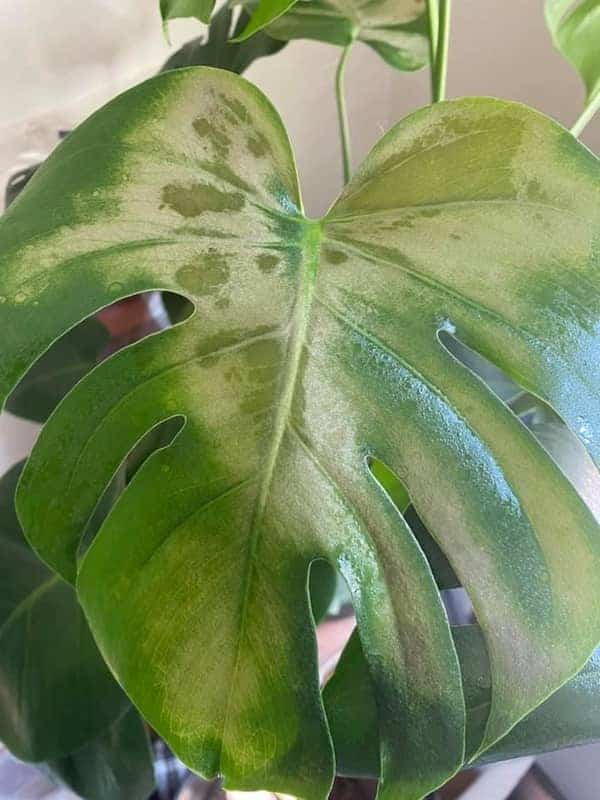
Temperature and Humidity
The temperature may cause brown spots on the leaves in two ways. If it’s too hot and dry, the monstera may suffer from heat stress, leading the plant to wilt.
Leaves start showing brown spots until it gets brown and crisp.
When it’s too cold, the monstera leaves may develop chill spots due to contact with cold drafts or windows. These spots would look brown after.
However, humidity is an agent for pathogen reproduction, especially when it’s relatively high.
These organisms thrive in a moist environment. Pathogens like fungi are the main contributors to mapping brown spots on the leaves.

Pest Infestation
Pests love munching on the leaves, sucking juices from their tissues, and making them food.
Unfortunately, they create wounds that look like brown spots. When left without intervention, they can create significant damage to the plant.
Insects like mealy bugs, spider mites, thrips, gnats, and scales are the common enemy of a monstera.
Some of them even poison the plant. When you see brown spots on the leaves, these pests might be the culprit behind them.
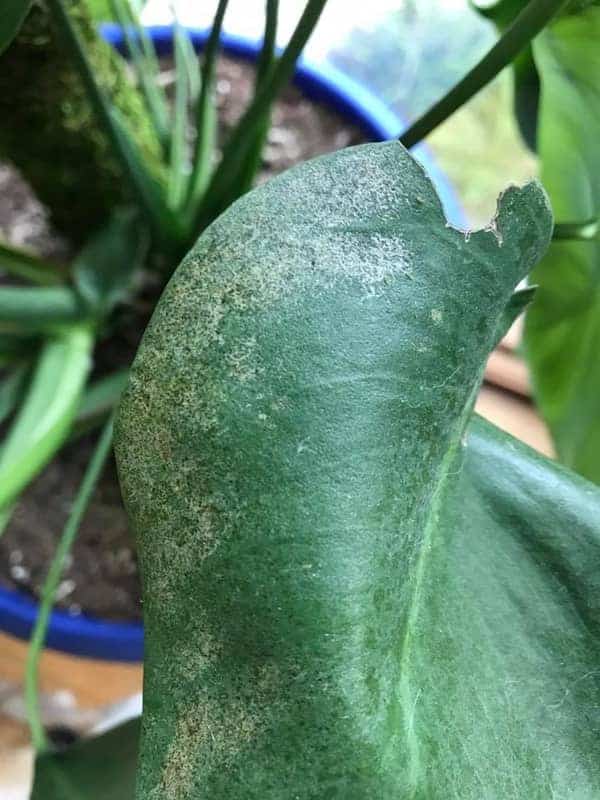
The image shows thrips in action. Remove the silvering from the underside of the leaves by wiping them down with a 50:50 solution of meths and water with a cotton ball.
The silvering will remain because they have sucked the chlorophyll (green stuff) out of the plant cells. They’re usually found beneath the leaves of a tree.
Rust Causes Brown Spots on Monstera Leaves
Rust is an infection caused by fungi, widespread in ornamental plants like monstera.
From the name itself, this infection creates rusty color on the surface and underside of the leaves. At first glance, the leaves would appear chlorotic, but it’s not.
These rust fungi spread on the leaves by producing spores that have powdery textures.
They create lesions on the various parts of the leaves. Sometimes, these lesions combine, creating large brown spots.
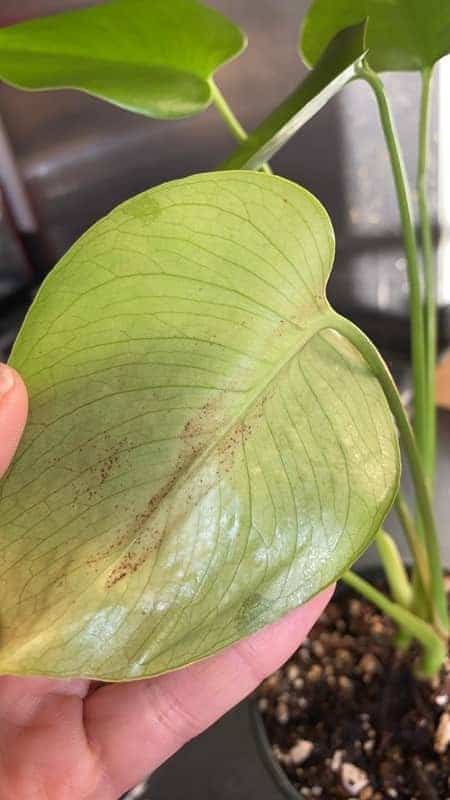
Brown Bumps on Monstera Stem
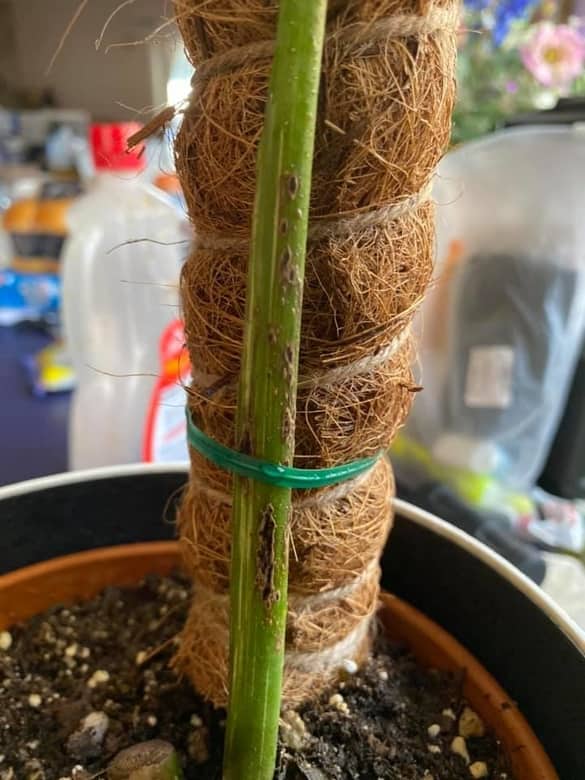
Since I noticed these black/brown dots/raised bumps on the stems, one stem has become discolored, and the tips of one leaf have yellowed.
In this case, ensure there are no pests, especially on the backside of the leaves. If the stem is tied with a pole, loosen the ties slightly; you’re just scraping the petiole.
If it rusts like bumps, you need to get into action.

This is a fungal infection that is unfortunately very difficult to eradicate – it nearly killed my entire giant Monstera, but I was able to save it by doing the following (though it has a lot fewer leaves now).
- Isolate right away!
- Put an end to the misting of the leaves.
- Wipe it down with a wet paper towel (so you can throw it out)
- Once a week, use a good rose spray containing a fungicide to coat all leaves and stems (top and bottom).
- Badly infected leaves, such as the ones in your photos, are too far gone, and you’re better off cutting them off and protecting any new growth from getting from the already infected leaves.
Even if you clear it, the leaf discoloration usually persists, so you’ll still have a spotty leaf.
My plant went from 8 to 3 leaves (due to me cutting them off), but it quickly produced two massive beauties and is now disease-free!
Fertilizer Problems
Adding fertilizer is okay to keep the monstera plant lush and healthy. Your plant will surely enjoy the added nutrients in the soil. But anything that goes beyond what it needs will hurt the plant.
Once added in excess, fast-release fertilizers will cause the burning of cells due to salt build-up.
Too much salt available near the roots will lead to osmotic stress, meaning water in the cell will leave in rapid motion. Cells are then left shrinking and dying.
It acts fast, so in only one to two days, you’ll notice the brown spots appearing on the leaves.
If not acted on immediately, it can lead to the sudden death of a monstera. So, you have to be very careful in doing fertilizer applications.
Incorrect Watering Leads to the Browning of Leaves
Knowing how to sufficiently provide plant water is a skill every plant owner must acquire.
The tricky part is that plants differ in the way they utilize water. So, you must understand how much water it needs and when it needs it.
Root rot is the result of overwatering your monstera. Read this article to know how to save overwatered monstera.
Nutrients and water transport are then compromised because of this. The next thing you know is that its leaves start showing brown spots until it’s all over the plant. Gradually the leaves turn yellow.
Water deficiency can also lead to the scorching of leaves, especially on its margins. When water isn’t enough, the plant suffers from drought stress.
This is where the cells lose their turgidity or swollen appearance because there’s not enough water coming in.
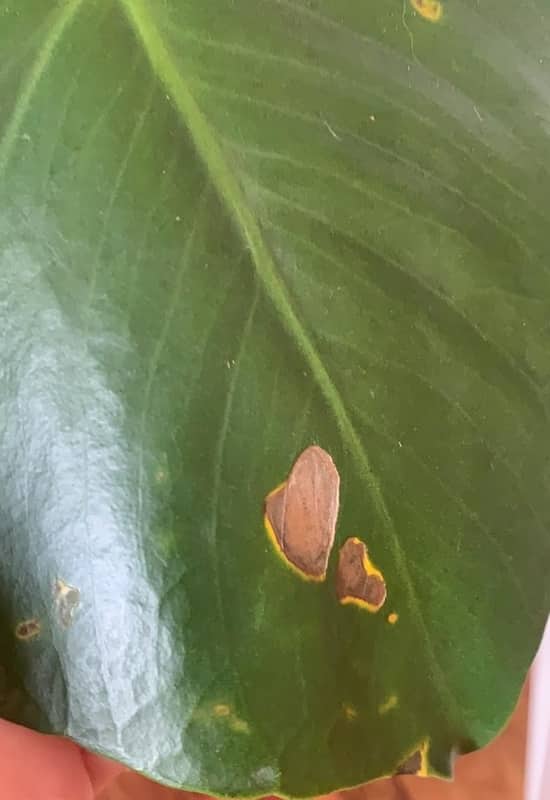
Water Quality
We’ve mentioned earlier that some pathogens can be transferred to another plant through irrigation.
If you’ve used water that’s previously contaminated with pathogens, they can start infecting the monstera.
Another thing is when the water used has high salt content, the plant will have a hard time absorbing water from the soil.
This is another source of stress for the plant. Excessively saline water will lead the plant cells to shrink and die. Your monstera will have brown tips as a symptom.
Outwardly, you’ll observe the leaves developing red to brown spots. Monstera has a low tolerance for salty soils.
How Do You Treat Brown Spots on Monstera?
Although brown spots on leaves aren’t much of a problem, you’ve got to pay close attention once you notice them growing and expanding.
Any treatment has to be done as early as possible to avoid extreme damages. There are instances that monsters will face death if it’s left untreated.
Relocate the Plant
Monstera prefers indirect light. If it has contact with strong, direct light for many hours, you must find a new location. If necessary, put a shade around it as protection.
You may also alter the light condition in your home if you’re using an artificial light source.
Avoid Exposure to Extreme Temperatures and Humidity
Make sure to put it away from a fireplace where there’s too much heat from a window that gets extremely hot or cold, depending on the weather.
Remove the plant from any source of cold drafts, such as air conditioners or fans.
You just have to be mindful of the existing condition inside your room. Anticipate how these extremes will affect your plant’s health in general.
Manage the Pests Before It Turns Your Plant Down
Pests multiply very fast and can cause major damage to the plant in just a few days.
If it’s manageable, manual removal of pests will do. Make sure to pluck out severely damaged leaves as well.
If the damage is beyond control, use a pesticide that’s appropriate to eliminate the unwanted organisms.
Just be careful in applying these chemicals to avoid harm. You may also opt for organic and DIY solutions at home to save money.
Remove Infected Plants and Put them Away from the Others
The last thing we want is to have them spread the disease to other host plants. Isolate the infected monstera when you treat them.
Bring them back only when it’s well again. Dispose of the infected parts properly to avoid cross-contamination.
You can burn these leaves or treat them with fungicide first before you bury them somewhere far away from any garden. Clean the tools you’ve used.
Leach Off Excess Fertilizers
If the brown spots are caused by too much fertilizer, you can use water to leach the salts off the soil. These salts are water-soluble, so it’s not that hard.
Pour in ample water on the soil until it drips off the pot. You can do this several times. Make sure the water drains off completely from the pot to avoid root rot.
Moderate Your Water Application
If water is the problem, then it’s water you control. Overwatered monstera should be allowed to dry off first by exposing them to moderate sunlight. This is to help the water evaporate faster. Repot the plant if necessary.
Underwatered monstera should be given enough water immediately until the leaves start looking full and vibrant. Drip irrigation is the key to ensuring that water reaches the bottom of the soil.
How To Prevent Brown Spots on Monstera Leaves?
As a living organisms, the different stresses plants experience affect them. These stresses can be naturally induced or not.
You must avoid or at least lessen these stresses to prevent brown spots from tarnishing monstera leaves.
Less stress leads to a healthier plant. So, here are a few preventive measures to avoid brown spots on your monstera leaves.
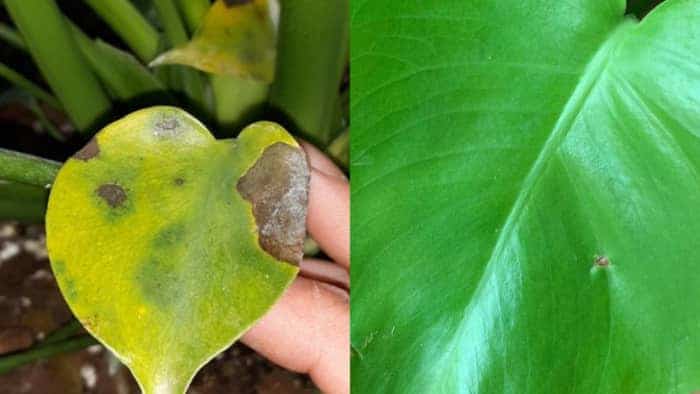
Give Sufficient Indirect Light
It’s an indoor plant, so it thrives well in an environment as such. Do not allow the monstera to be exposed to direct sunlight. Or, if you do, make sure it’s not exposed too long.
This plant can utilize indirect light for photosynthesis, so there’s no point in exposing them to harsh conditions outside. It will just stress out the plant.
Prepare for Hot Days and Cold Days
If you have a working air conditioner that you turn on when days are hot, your monstera will surely benefit.
The added coolness will prevent the leaves from developing brown spots caused by heat stress.
Insulation should be ready as well in anticipation of the winter season. Finding a safe location is another thing that will save the monstera from having chill spots.
If you’re seeking ways to ensure your monstera flourishes through the winter, then this article contains all the essential information you need.
Always Be on the Lookout for Pests
Never take a single pest lightly. They often work in a subtle way, growing rapidly in just a day. Before you know it, these pests may have infected the leaves heavily.
The moment you see foreign organisms roaming around your plant, remove it. Some pests can be taken care of by directly spraying them.
Others can be manually removed using your fingers. Be careful to kill and dispose of them immediately.
Cut Off Infected Leaves As Soon as Possible
This is especially applicable if the cause of brown spots is due to diseases and pests.
Removing infected leaves will help mitigate the spread of infection. Don’t worry because your monstera will surely grow new ones.
Getting rid of the infected parts as soon as possible is better than risking the entire plant of heavier infection.
Regularly Water Your Monstera
Monstera is a huge indoor plant that would need more water supply. Water the plant 2 to 3 times a week or until the soil is at least 50 to 70% dry. This, of course, depends on the season.
Always check if the water drains off completely. Use a hose, as much as possible, to ensure the pot is deeply watered. Water all around inside the pot to provide uniform moisture on the soil.
Always Start with a Healthy Soil
When potting, choose sterilized soil to ensure pathogens have been killed. This will lessen the possibility of transferring diseases to your monstera. Pathogens can live in the soil for a long time.
A well-amended soil rich in organic matter will keep the plant strong and healthy. Nutrients made available in the soil in sufficient amounts will lessen fertilizer application. Slow-release fertilizers are also preferred.
Use Clean Water
It’s straightforward to transfer fungi and bacteria through the water. If you’re using water that’s not clean, it’s possible to inadvertently transfer these harmful organisms to your plant, causing further harm.
Tap water is enough, but if you have the chance to catch rainwater, it would be even better. Rainwater is free from chemicals and other treatments, so the plants love them.
Notice that plants outside, after being drenched with rainwater, will instantly look vibrant and good.
Avoid Excessive Moisture
Misting can help the plant on hot days but not when relative humidity is high. A moist environment is friendly to pathogens. You’re giving them a chance to multiply.
Allow excess moisture to evaporate off the plant by applying water only in the morning and not in the evening. That way, there’s enough time to lose the water throughout the day.
Can You Maintain Healthy Monstera Leaves?
Taking care of monstera is extra challenging because this indoor plant is normally huge. Seeing brown spots on its leaves will certainly bring panic. You may be having doubts about making your monstera a success story.
But, with proper knowledge and understanding of the factors above, you’ll surely figure out how to manage them properly.
The goal is to create a favorable environment for the plant to enjoy. Minimize the stress, and your monstera will surely do well. Can you do that?






